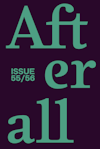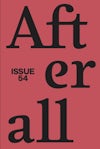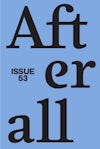
Issue 33
Summer 2013
Issue 33 looks at performativity in contemporary art through the work of Josef Dabernig, Mark Leckey, Xavier Le Roy and Simryn Gill. Accompanying essays examine lecture-performances and televisual objecthood, while monographic articles consider the projects ‘Pacific Standard Time’ and ‘Desacuerdos’.
Editors: Nuria Enguita Mayo, Melissa Gronlund, Anders Kreuger, Pablo Lafuente, Stephanie Smith, Helena Vilalta, Louise O’Hare.
Founding editors: Charles Esche, Mark Lewis.
Table of contents
Foreword
Contextual Essays
- When Form Starts Talking: On Lecture-Performances – Rike Frank
- Televisual Objects: Props, Relics and Prosthetics – Maeve Connolly
Artists
Xavier Le Roy
- Xavier Le Roy: La Règle du jeu – Chris Sharp
- Xavier Le Roy: A Discipline of the Unknown – Marcella Lista
Mark Leckey
- Mark Leckey: Formal Love
- Mark Leckey’s Anima Mundi – Esther Leslie
Simryn Gill
- Present and Unread: Simryn Gill’s ‘Where to draw the line’ – Weng Choy Lee
- ‘O, Outside, show me your innermost!’: Simryn Gill’s ‘My Own Private Angkor’ – Anders Kreuger
Josef Dabernig
- Josef Dabernig: A Sort of Introduction – María Berríos
- ‘Dein Muff makes me drunk’: The Films of Josef Dabernig – Daniel Fairfax
Events, Works, Exhibitions
- Rupture and Continuity in Feminist Re-performance – Chan, Alexandra Grant & Elana Mann
- A Critical Approach to the Project ‘Desacuerdos’ – Valentín Roma
Foreword
The book accompanying me on bus and train journeys around Chicago lately has been a slim, potent text by the political theorist Danielle Allen. Although it considers events that unfolded half a century ago, Talking to Strangers: Anxieties of Citizenship Since Brown v. Board of Education (2006) feels relevant right here and right now (and yes, if you’ll bear with me, also to this issue of Afterall journal). 1 The book does not merely analyse the impact of the pivotal 1954 ruling by the US Supreme Court that declared racial segregation to be unconstitutional. Rather, Allen tackles a more subtle and urgent task: she uses that moment and its aftermath to make a case that citizenship is enacted not only through policy and law but also through habits of ‘political friendship’. She urges us to take up the difficult work of being open to others across disagreement and difference (real or perceived). Most importantly, she argues that active citizenship requires us to ‘talk to strangers’ — both literally and metaphorically — as a daily practice and especially during times of crisis.
I mention that book here for a few reasons. For one, Allen begins a story about politics by looking closely at an image: a now-famous photograph that depicts a young black woman walking past a white crowd 2. Behind her, an equally young white woman — mouth open and face contorted with what seems to be hatred — yells at her back. This picture gave visceral form to the impact of Brown v. Board of Education by depicting Elizabeth Eckford calmly enduring the crowd’s rage on that day in September 1957, shortly after she was barred from what should have been her first day of high school in Little Rock, Arkansas, with Hazel Bryan standing in for all those who sought to keep black US citizens from claiming their rights.
Allen argues that this widely circulated picture made a moment of national fracture visible, and thus opened the possibility that we might imagine the public sphere in new ways:
Once the citizenship of dominance and acquiescence was made public, citizens in the rest of the country had no choice but to reject or affirm it. The photograph forced a choice on its US viewers, and its power to engage the imagination lay in this … Even today, the photograph provokes anxiety in its audience not merely about laws and institutions but more about how ordinary habits relate to citizenship. Like the German poet Rilke’s archaic torso of Apollo, the image of Hazel cursing Elizabeth raises the challenge of transformation not of laws but of ourselves: Du musst dein Leben ändern, wrote Rilke. Or, you must alter your way of life. 3
Of course, one could argue with the reading and also with the specifics of Allen’s polemics. In relation to the concerns of Afterall, the image in question may also seem outside our usual purview, for it was not conceived by its maker or received by its public as a work of art. But regardless of its potential status (as art or not), Allen’s reading of this photograph strongly resonates with our work, for we also believe that pictures matter and that they have important things to say.
Purchase
The publication is available for purchase. If you would like specific articles only, it is also available individually and to be downloaded as PDFs.
Purchase full publication
Buy via University of Chicago Press
Buy via Central Books
Purchase individual articles
Buy via University of Chicago Press



